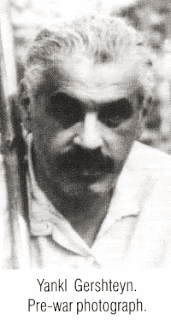Saturday, September 25, 2021--5:30-7:30 pm Pacific
We should read Abraham Karpinowitz's stories of Vilna for a much-needed complement--if not antidote-- to our most recent book, Chaim Grade'sThe Yeshiva. While Grade submerges us in the dour, ethically demanding culture of Musar, Karpinowitz's stories in Vilna My Vilna take us out into the Jewish streets of the city.

The collection introduces us to working class men and women, and their aspirations and schemes for a better world, schemes shaped both by poverty and the rich community life of Jews in the interwar period in Polish-occupied Vilna. Proletarian idealists appear and reappear in these pages--among them, a
youthful communist in the underground party willing to risk a jail sentence for stealing into a public square at night to hang a red flag, a Zionist dreamer who starts his own bank to issue 'Jewish money' in order to get people used to having their own state and their own currency, and a reporter for a Yiddish newspaper who writes prudish theatre reviews of bawdy acts while trying to organize a union for Jewish prostitutes.

Jewish porters waiting for work outside Vilna's central theatre. Source: eilatgordinlevitan.com
Writing respectively from Canada and the United States in the postwar period, Abraham Karpinowitz and Chaim Grade each carries the double burden of the post-Holocaust Yiddish writer--to reconstruct his memory of a Jewish world that was destroyed and also to continue writing in a language that few remaining people in their time, and in the likely future, would read. In these tasks, Grade is unable--perhaps unwilling--to free his conscience from the heavy weight of his Musar training. Karpinowitz writes with an easier consciences and a lighter touch.
Reviewing Sandra Studer's recent book in German comparing the two authors' portrayal of Vilna's cultural geography, the critic Mikhail Krutikov writes: "Grade created a series of deeply empathic portraits of poor and pious inhabitants of the Jewish old town, whereas Karpinovitsh examined the impact of modernity on everyday Jewish life." But there is more.

Vilna's Jewish co-ed rowers, members of the Maccabee sports team. Source: eilatgordonlevitan.com
Perhaps the most striking difference lies in the emotional tone of the authors' works. Karpinowitz bathes his stories with love for his city, its streets filled with shops and vendors, its lilac-covered hills in spring, the flowing Viliye River with its barges and bridges connecting the Old City with the working-class Jewish neighborhood of Shnipishok, picnics on the banks and in nearby forests, the loud voices of women selling fish in the market, and the denizens of the Shulhoyf, the center of Vilna's Jewish world, located between Yiddish Street and Daytsch Street.

Velfke Usian's tavern and restaurant, the well-known hangout of Jewish artists, actors, writers and intellectuals. The spot was located across from the Shulhoyf in the center of the Jewish Old City. Source: eilatgordinlevitan.com
Through Karpinowitz, we rub elbows with ordinary people in the more significant moments and situations of their ordinary lives--an aspiring barbershop owner whose equipment is stolen, a Yiddish folklore collector who courts a widow selling fish in her market stall, a kingpin criminal who saves the life of the Polish president Josef Pilsudski, a revered educator who falls in love with a famous actress, a prostitute who goes defiantly to her death with untold dignity--facing Nazis with machine guns in the Ponary forest during the three-year extermination of 70,000 Jews beginning in July 1941.
We believe in the reality of these characters, convinced that they are more than a writer's conceits disguised as real people. They are as real as the city's streets through which Karpinowitz traces their comings and goings. In part, they appear to be real because so many of Vilna's celebrated figures exist side by side and in conversation with them in these stories. Among the famous individuals are Avrom Morevski, the actor; Max Weinreich, the director of the YIVO Institute for Jewish Research (Yidisher visnshaftlekher institut); Velfke Usian, tavern owner; Dina Halperin, the actress; Avrom Sutzkever, the poet; Yankev Gershteyn, the beloved music teacher and composer, and many others. Translator Helen Mintz helpfully provides an extensive glossary of "people, places, terms and events' that Karpinowitz mentions. I counted 151 entries.
Composer and educator Yankev Gershteyn and Polish-born actress Dina Halperin, whose brief romance causes her jealous acting partner to thwart the relationship . Sources: yleksikon.blogspot.com (Gershteyn) and flikr.com (Halperin).
You won't find the author Abraham Karpinowitz listed in the Dictionary of Literary Biography, Volume 333, Writers in Yiddish, however, where you might expect his name to belong. But Karpinowitz's considerable works include, translator Helen Mintz tells us in the Introduction, seven works of fiction, a biography and a play, including the stories in this book. This fact alone reminds us to put in check the initial temptation to read Vilna, My Vilna as memoir (just as we had to do when reading Esther Singer Kreitman's novel Dance of the Demons). Scholar Justin Cammy, in the book's Foreword, tips the cards in this direction: "His stories often relied on private memories or collective folklore of a specific prostitute, underworld figure, wagon driver, street activist or lunatic." In the Introduction, Helen Mintz also writes:
In his imaginative recreation of the vanished city of Vilna, Karpinowitz often blurs the line between fact and fiction. He intertwines the lived with the imagined and the realistic with the whimsical to create "literary authenticity, a storyteller's truth, which he maintains even in the sometimes implausible and fanciful situations he creates."



Comments